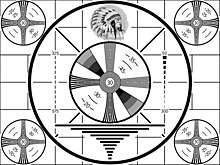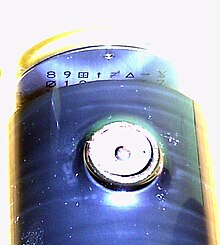
Analog television is the original television technology that uses analog signals to transmit video and audio. In an analog television broadcast, the brightness, colors and sound are represented by amplitude, phase and frequency of an analog signal.

A cathode-ray tube (CRT) is a vacuum tube containing one or more electron guns, which emit electron beams that are manipulated to display images on a phosphorescent screen. The images may represent electrical waveforms (oscilloscope), pictures, radar targets, or other phenomena. A CRT on a television set is commonly called a picture tube. CRTs have also been used as memory devices, in which case the screen is not intended to be visible to an observer. The term cathode ray was used to describe electron beams when they were first discovered, before it was understood that what was emitted from the cathode was a beam of electrons.
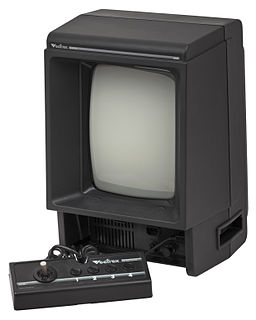
The Vectrex is a vector display-based home video game console–the only one ever designed and released for the home market, developed by Smith Engineering. It was first released for the North America market in November 1982 and then Europe and Japan in 1983. Originally manufactured by General Consumer Electronics, it was later licensed to Milton Bradley after they acquired the company. Bandai released the system in Japan.
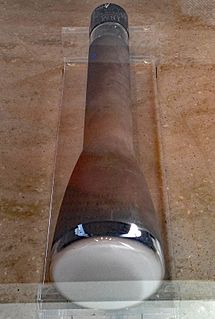
The Williams tube, or the Williams–Kilburn tube after inventors Freddie Williams and Tom Kilburn, is an early form of computer memory. It was the first random-access digital storage device, and was used successfully in several early computers.

A test card, also known as a test pattern or start-up/closedown test, is a television test signal, typically broadcast at times when the transmitter is active but no program is being broadcast.

The Selectron was an early form of digital computer memory developed by Jan A. Rajchman and his group at the Radio Corporation of America (RCA) under the direction of Vladimir K. Zworykin. It was a vacuum tube that stored digital data as electrostatic charges using technology similar to the Williams tube storage device. The team was never able to produce a commercially viable form of Selectron before magnetic-core memory became almost universal.

An electron gun is an electrical component in some vacuum tubes that produces a narrow, collimated electron beam that has a precise kinetic energy. The largest use is in cathode ray tubes (CRTs), used in nearly all television sets, computer displays and oscilloscopes that are not flat-panel displays. They are also used in field emission displays (FEDs), which are essentially flat-panel displays made out of rows of extremely small cathode ray tubes. They are also used in microwave linear beam vacuum tubes such as klystrons, inductive output tubes, travelling wave tubes, and gyrotrons, as well as in scientific instruments such as electron microscopes and particle accelerators. Electron guns may be classified by the type of electric field generation, by emission mechanism, by focusing, or by the number of electrodes.
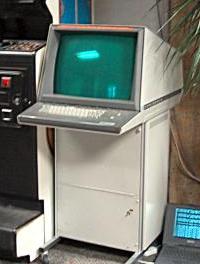
Storage tubes are a class of cathode-ray tubes (CRTs) that are designed to hold an image for a long period of time, typically as long as power is supplied to the tube.
An output device is any piece of computer hardware equipment which converts information into a human-perceptible form or, historically, into a physical machine-readable form for use with other non-computerized equipment. It can be text, graphics, tactile, audio, or video. Examples include monitors, printers, speakers, headphones, projectors, GPS devices, optical mark readers, and braille readers.

The Indian-head test pattern is a test card created by RCA of Harrison, New Jersey, for calibration of the RCA TK-1 monoscope. It features a drawing of a Native American wearing a headdress and numerous graphic elements designed to test different aspects of broadcast display. The card was introduced in 1939 and over the course of the black-and-white television broadcasting era was widely adopted by television stations across North America.

A character generator, often abbreviated as CG, is a device or software that produces static or animated text for keying into a video stream. Modern character generators are computer-based, and they can generate graphics as well as text.

Charactron was a U.S. registered trademark of Consolidated Vultee Aircraft Corporation (Convair) for its shaped electron beam cathode ray tube. Charactron CRTs performed functions of both a display device and a read-only memory storing multiple characters and fonts. The similar Typotron was a U.S. registered trademark of Hughes Aircraft Corporation for its type of shaped electron beam storage tube with a direct-view bistable storage screen.

The 7JP4 is an early black and white or monochrome cathode ray tube. It was a popular type used in late 1940s low cost and small table model televisions. The 7JP4 has a 7" diameter round screen which was often partially masked. Unlike later electromagnetically deflected TV tubes, the 7JP4 is electrostatically deflected like an oscilloscope tube.
The beam-index tube is a color television cathode ray tube (CRT) design, using phosphor stripes and active-feedback timing, rather than phosphor dots and a beam-shadowing mask as developed by RCA. Beam indexing offered much brighter pictures than shadow-mask CRTs, reducing power consumption, and as they used a single electron gun rather than three, they were easier to build and required no alignment adjustments.
This is a subdivision of the Oscilloscope article, discussing the various types and models of oscilloscopes in greater detail.
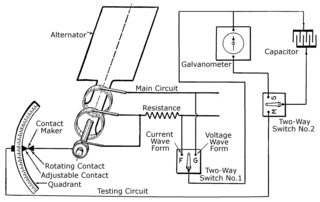
The history of the oscilloscope reaches back to the first recordings of waveforms with a galvanometer coupled to a mechanical drawing system in the second decade of the 19th century. The modern day digital oscilloscope is a consequence of multiple generations of development of the oscillograph, cathode-ray tubes, analog oscilloscopes, and digital electronics.
Laser-powered phosphor display (LPD) is a large-format display technology similar to the cathode ray tube (CRT). Prysm, Inc., a video wall designer and manufacturer in Silicon Valley, California, invented and patented the LPD technology. The key components of the LPD technology are its TD2 tiles, its image processor and its backing frame that supports LPD tile arrays. The company unveiled the LPD in January 2010.

Beam deflection tubes, sometimes known as sheet beam tubes, are vacuum tubes with an electron gun, a beam intensity control grid, a screen grid, sometimes a suppressor grid, and two electrostatic deflection electrodes on opposite sides of the electron beam, that can direct the rectangular beam to either of two anodes in the same plane. They can be used as two-quadrant, single-balanced mixers or (de)modulators with very linear qualities, their mode of operation similar to one-half of a Gilbert Cell, by applying an unbalanced signal f1 to the control grid and a balanced signal f2 to the deflection electrodes, then extracting the balanced mixing products f1 − f2 and f1 + f2 from the two anodes. Similar to a pentagrid converter, the cathode and the first two grids can be made into an oscillator. Two beam deflection tubes can be combined to form a double-balanced mixer.
A time base generator is a special type of function generator, an electronic circuit that generates a varying voltage to produce a particular waveform. Time base generators produce very high frequency sawtooth waves specifically designed to deflect the beam of a cathode ray tube (CRT) smoothly across the face of the tube and then return it to its starting position.
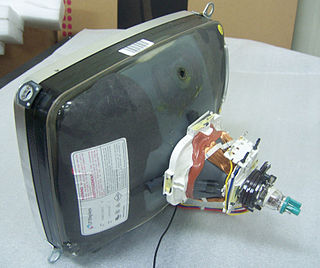
A deflection yoke is a kind of magnetic lens, used in cathode ray tubes to scan the electron beam both vertically and horizontally over the whole screen.
